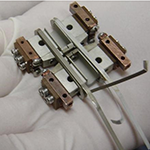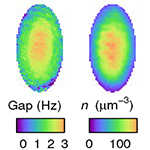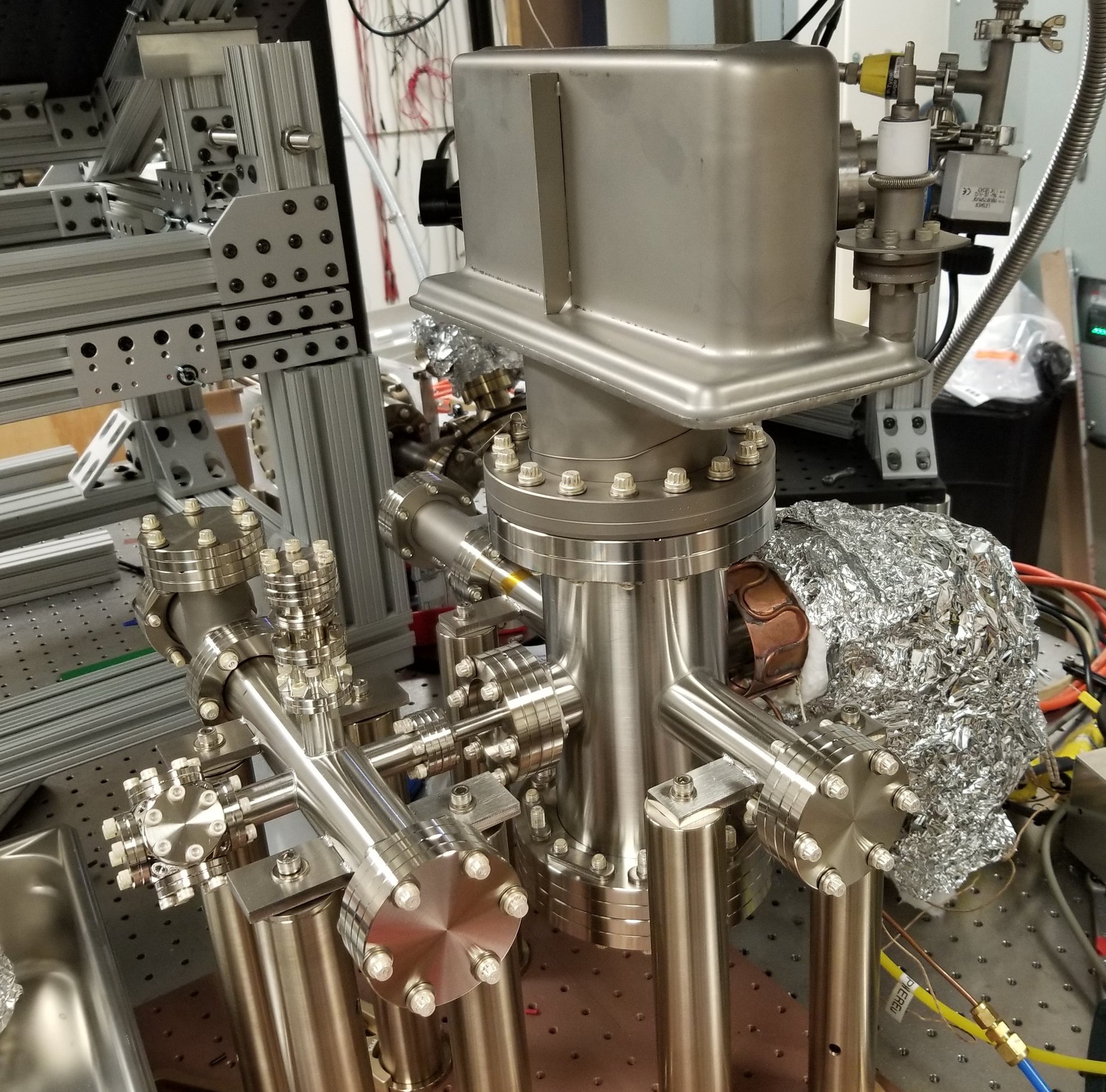
Nothing lives forever, not even the experiments that we’ve built up over the years. There comes a time when an experiment is outdated by technological advances, when major scientific questions have either been answered or deemed inaccessible, or when we weigh the relative benefits of still using an old apparatus and of building something new. Experiments are then retired. But the scientific knowledge they generated is permanent. Spare parts are repurposed. Lessons learned continue to inform our work. Students and postdocs who built, tended, and explored nature with the experiments move on to do great things.
Below, we provide a chronicle of retired experimental efforts.
E1: 87-Rubidium BEC experiment
E1 is the very first experiment built in the Berkeley Ultracold Atomic Physics group. This apparatus used an atomic beam, Zeeman slower, and in-vacuum Ioffe-Pritchard magnetic trap to produce Bose-Einstein condensates of 87-Rb, with condensate numbers in the range of several million atoms. The prime use of the experiment was for the study of spinor Bose-Einstein condensates. It was here where we first learned how to image the magnetization of a quantum gas through birefringent phase contrast imaging, and then applied that technique to study the spontaneous symmetry breaking that occurs when a spinor Bose-Einstein condensate is quenched across a quantum phase transition. This experiment led to the demonstration of spatially resolved magnetometry using ultracold atoms, quantitative tests of the magnification of spin fluctuations that occurs from the spin-mixing interaction, observation of magnetic dipolar effects in the dynamics of spinor condensates, and to an observation of persistent magnetization inhomogeneity in spinor Bose-Einstein gases at variable temperature. We also investigated several aspects of nonlinear optics in a Bose-Einstein condensate, discovering a method to image optically the coherent portion of a quantum-degenerate Bose gas at non-zero temperature. Theoretical studies surrounding and stemming from our work include the first introduction of the idea of Raman dressing to modify the dispersion relation, superfluid critical velocity, and many-body quantum state of a quantum gas, which led eventually to studies by others of spin-orbit coupling and effective magnetic fields for neutral atoms, and also theoretical investigations of quench dynamics and of spin-nematicity squeezing in a multi-mode quantum field.
Details on the construction and operation of E1 can be found in the doctoral dissertations of James Higbie, Lorraine Sadler, Sabrina Leslie, and Jennie Guzman.
The E1 experiment was modified extensively by a total replacement of the vacuum chamber, while retaining, with significant modification, its laser optics, experimental control, magnetic field control, and imaging sub-systems. This heavily modified experiment was renamed “E5,” and is described here.
E2: Ring trap and cavity QED
E2 was among the first experiments worldwide to study ultracold atomic gases within optical cavities in the regime of single-atom/single-photon strong coupling. Atoms were trapped magnetically, transported with a moving spherical-quadrupole trap, deposited into a novel mm-scale magnetic trap, and thence finally into a standing wave optical trap formed by light inside a near-planar Fabry-Perot resonator.
En route to realizing quantum optics experiments, we realized a novel magnetic trap configuration in which the trap forms a closed ring and acts as a circular waveguide, presenting new possibilities for atom optics and studies of quantum gases in non-simply connected geometries. We characterized the coherence of atom laser pulses guided by this ring trap using nonlinear optics, and observed betatron resonances similar to those observed in particle accelerators.
Once our quantum-optics experiments got underway, we were immediately struck by pronounced effects of the motion of trapped ultracold atoms on the optical response of a strongly coupled cavity. We observed nonlinear effects such as cavity bistability and hysteresis, even when probing the cavity extremely weakly, with intracavity photon numbers far below unity. We eventually understood this extreme cavity nonlinearity to be the result of cavity optomechanics, where, in our case, the collective motion of a trapped atomic gas served as the mechanical element (our ICAP paper from 2009 explains our thinking). The strong cavity cooperativity, low mass of an atomic gas, and strong near-resonant atomic polarizability all led to a novel regime of cavity optomechanics where not only are quantum backaction effects dominant, as we demonstrated by measuring the quantum noise of radiation pressure, but also where single-phonon/single-photon coupling is strong.
Other important results from E3 are the experimental study of magneto-optical traps that are loaded directly from an alkali-metal dispenser, and theoretical studies including a study of the transmission spectrum of a cavity containing a fixed number of atoms, where we account for the motional dynamics of the atoms and consider how precisely the number of atoms can be counted via the cavity transmission, and also a study of whether Fock states of light (fixed number of photons in a single mode) can be produced from a driven cavity containing a fixed number of atoms.
Details on the construction and operation of E2 can be found in the doctoral dissertations of Kevin Moore and Kater Murch.
Simultaneously with operating E2, we began also to develop a next generation setup that integrated strongly coupled optical cavities onto an atom chip. This newer experiment, now called “E3”, initially shared much of the experimental hardware such as laser cooling and cavity stabilization optical systems and the experimental control system (through a big switchyard of digital and analog channels). Around 2009, while we had intended for the two experiments to coexist for a time, we found ourselves struggling to operate E2 (after the experimental magicians who had built it graduated and left the group) while also appreciating the advantages of the E3 setup. At this point, E2 was decommissioned. Its vacuum chamber sat on its optical table like an enormous paperweight for about a decade, until it was finally dismantled in 2018 and many of its parts repurposed for our titanium laser cooling experiment (E8).
E3: Cavity on a chip
By integrating trapped ensembles of ultracold atoms and high-finesse cavities with an atom chip we are able to study and control the classical and quantum interactions between photons and the internal/external degrees of freedom of the atom ensemble.
Using copper wires embedded in an atom chip, we magnetically trap and transport an ensemble of ultracold Rb-87 atoms into a high-finesse optical cavity. We then transfer the ensemble into a single node of a standing-wave optical dipole trap, resonant with a very far-detuned longitudinal mode of the cavity. A 780nm probe laser, resonant with another longitudinal cavity mode and detuned from the atomic D2 transition, dispersively interacts with the atomic ensemble. The coupling of the atomic ensemble to the standing-wave probe intensity is position- and spin-dependent. Probe light transmitted through the cavity mirrors therefore carries information about the collective position and spin of the ensemble, which is recorded using an optical heterodyne receiver.
The interaction of the probe with the spin of the atomic ensemble results in scalar and vector Stark shifts of the atomic states, along with a dispersive cavity shift proportional to the total atomic spin component along the cavity axis. The vector component of the Stark shift acts as an effective magnetic field along the cavity axis, and the dispersive shift facilitates measurement of one component of the total atomic spin.
Spin optodynamics: For small excitations, a spin-polarized atomic ensemble precessing around a magnetic field transverse to the cavity axis can be described like a simple harmonic oscillator. The component of the total spin along the cavity axis is measured by the probe, resulting in measurement back-action in the orthogonal component, required in order to satisfy the spin uncertainty relation. Considering these the position and momentum of a harmonic oscillator, respectively, this is directly analogous to cavity optomechanics, immediately yielding many similar results as developed in our previous theory paper.
Recent E3 experiments have focused on realizing these spin-optodynamics analogues of optomechanics, as well as exploring some of the unique features a spin oscillator presents, such as a widely tunable Larmor frequency, a zero-temperature thermal bath, and a negative temperature, high-energy 'ground state'.
Optomechanics in a superlattice: Atoms trapped in optical superlattice modulate the probe at distinct frequencies. With two optical dipole traps of incommensurate wavelengths, we create an array of loading sites with differing mechanical resonance frequencies, allowing us to separate spectrally the responses of atomic motion from neighboring sites.
This mechanical resonance separation technique has allowed us to apply and measure forces with unprecedented sensitivity and to couple mechanical oscillators together via the cavity probe field. For the latter experiment, we can observe the state of each oscillator evolve with or without coupling. Because the photonic coupling field can be measured as it exits the cavity, this kind of coupling necessarily introduces measurement backaction. In order to measure both the coupling-induced energy transfer and the coincident backaction, we acquire a statistical ensemble of many realizations of the coupling measurement.
Ponderomotive squeezing: Collective motion of the atoms' center of mass can act to suppress quantum noise fluctuations of the probe light. This suppression is called ponderomotive squeezing. When the main source of noise on our probe light is photon shot noise, the optomechanical system is dominantly driven by these quantum fluctuations in radiation pressure. In such a system, by detuning our probe light from cavity resonance we close the gain loop and allow the optomechanical response to interfere constructively and destructively with input optical fluctuations, leading to spectral windows of amplification and of sub-shot-noise squeezing.
E4: Magnons and Li-Rb mixtures
Our realization of the time-orbiting ring trap (TORT) in E2 drove us to build up an experiment dedicated to ring-trap interferometry with both Rb and Li gases. A lot of great ideas went into this experiment, including microfabricated electromagnet coils, a non-metallic heat sink to reduce inductive magnetic field inhomogeneities, a high-quality glass cell, dual-species Zeeman slowing and optics for a Li-Rb magneto-optical trap, mechanical and thermal stability, a new experimental control setup, and more. But we struggled to get everything working at once. Finding our atom interferometry goals receding, we redirected our efforts in three directions that proved fruitful.
Collective excitation Sagnac interferometry
Atom interferometry allows for highly sensitive and absolutely calibrated measurements of inertial effects, such as acceleration and rotation. Quantum degenerate gases could, in principle, allow for advancements in atom interferometry to improve inertial sensing. Yet, many efforts to utilize quantum degenerate matter for interferometry have been stymied by strong disturbances that arise from atomic interactions and, for trapped gases, from the perturbations of trapping potentials.
Phonon modes of various order in an optical ring trap.
We realized a proof-of-principle rotation sensor based on imaging the propagation of counter-rotating phonon waves in a ring-trapped Bose-Einstein condensate. This seminal work sets a precedent for future work being pursued in our group, in our collaborations, and by others. We established methods to image phonon perturbations in a ring trap, and to analyze their evolution so as to separate effects of trap perturbation from those of rotation.
magnons in spinor Bose-Einstein condensates
Magnon interferometry and spectroscopy
Precisely measuring the frequency of a collective excitation allows us to test the underlying physics of a many-body system. Here, we study magnons, collective spin waves, in a spin-1 ferromagnetic superfluid. We create collective excitations of different momenta, which appear as a spin density wave. The contrast of the standing wave oscillates in time as the momentum components evolve, giving a direct interferometric readout of the dispersion relation.
In-situ measurements of the magnon density show oscillation in the contrast resulting from interference between stationary and moving magnons. These oscillations measure precisely the magnon recoil frequency even within a dense Bose-Einstein condensed gas.
Magnon-based thermometry of deeply degenerate Bose-Einstein gases
Highly degenerate quantum gases at non-zero temperature differ from their zero-temperature counterparts by the presence of just a small fraction of excited atoms. Discerning these few excitations atop the rest of the gas is difficult, limiting the ability to measure temperature accurately. We discovered that adding a small admixture of magnons within a ferromagnetic Bose-Einstein condensate, and measuring their velocity distribution selectively, allows one to perform thermometry on Bose gases as low as 0.02 of the condensation temperature, where the entropy per particle is just 10^-3 kB. This is the lowest entropy ever measured in a gas (see press release).
Magnon cooling in deep traps
Magnons enable two types of cooling that work without lowering the trap depth, which might be constrained, for example, because it also controls the tunneling rate in a lattice: cycled-decoherence cooling/demagnetization cooling and magnon-assisted evaporation. In magnon-assisted evaporation, magnons increase cooling power of evaporative cooling by increasing the non-condensed phase space density. In cycled-decoherence cooling/demagnetization cooling, magnons created in a degenerate gas absorb energy from the majority-spin gas as they thermalize. After thermalization, the magnons can be expelled and the process repeated.
Magnon condensation in a spinor Bose-Einstein gas
Magnon condensation describes magnetic phase transitions in several equilibrium and non-equilibrium systems. We studied the condensation of magnon excitations within a ferromagnetic spinor Bose-Einstein condensate, characterizing the transition by the position and momentum distribution of the critical magnon gas, and by the spontaneous emergence of macroscopic transverse magnetization. The magnon condensate did not establish long-range order across the entire gas within experimental timescales. The cause for this persistent quasi-condensation remains undetermined.
Interactions in an ultracold 7Li - 87Rb gas mixture
Measurement of Li-Rb collision cross section in a spherical quadrupole trap
Atomic motion of a non-interacting gas in a spherical quadrupole trap is ergodic. The relaxation of the non-equilibrium momentum distribution of a dilute trapped 7-Li gas provided a quantitative measure of collisions with a background of trapped 87-Rb atoms. Working with Yimeng Wang and Chris Greene from Purdue University, we found our measured cross-section for 7Li-87Rb collisions to be significantly larger than predicted by theory, posing a puzzle for future experiments on the Li-Rb gas mixture.
Collisional spin transfer in a heteronuclear spinor Bose-Einstein gas
Heteronuclear spinor gases, composed of spinor gases of two or more atomic elements or isotopes, are predicted to show an array of magnetic phenomena that is much richer than seen in homonuclear spinor gas systems. We studied spin transfer between non-degenerate F=1 spinor gases of 7Li and 87Rb. In analogy with spintronics, Li played the role of an injected current and Rb the role of a magnetization bath. From the evolution of Zeeman-state distributions over time, we identified and quantified the strength of all heteronuclear spin-transfer processes, including spin exchange, spin mixing and quadrupole exchange. This is the first time all spin-dependent interactions in a heteronuclear spinor gas have been observed.
Details on the construction and operation of E4 can be found in the doctoral dissertations of G. Edward Marti, Ryan Olf, and Fang Fang.
E7: Ultracold molecules
Full quantum control over molecules in the ultracold regime has made remarkable progress in the past decade, but remains an open problem in the AMO physics community. The rich internal energy structure of diatomic molecules provides many flexible channels for quantum state manipulation. Specifically, molecules can rotate or vibrate back and forth, each of which contributes to the rich physics one can study.
In the case of heteronuclear molecules one can engineer large rotating or static electric dipole moments. These dipole moments give us an extra knob to perform manipulations on molecular systems, and can allow for the engineering of long-ranged, tunable, and anisotropic interactions. Ultracold molecules thus provide an intriguing platform to investigate quantum information technologies, quantum state-controlled chemistry, and the simulation of exotic strongly-correlated phases of matter!
This internal structure presents a plethora of interesting quantum phenomena to study in the laboratory, and an experimental challenge to control. We are presently investigating how each of these degrees of freedom plays into our ability to make and manipulate molecules in the quantum regime.
E7 is currently under construction to produce large, quantum degenerate mixtures of Lithium-7 and Rubidium-87 gases, and samples of ultracold ground state LiRb molecules. We are feeding a dual-species 3D magneto-optical trap (MOT) fed from a Zeeman slower and 2D-MOT, and plan to cool the atoms to quantum degeneracy through a sequence of magnetic and optical evaporation stages. After cooling, the atoms will undergo coherent quantum state transfer into tightly bound molecules.










